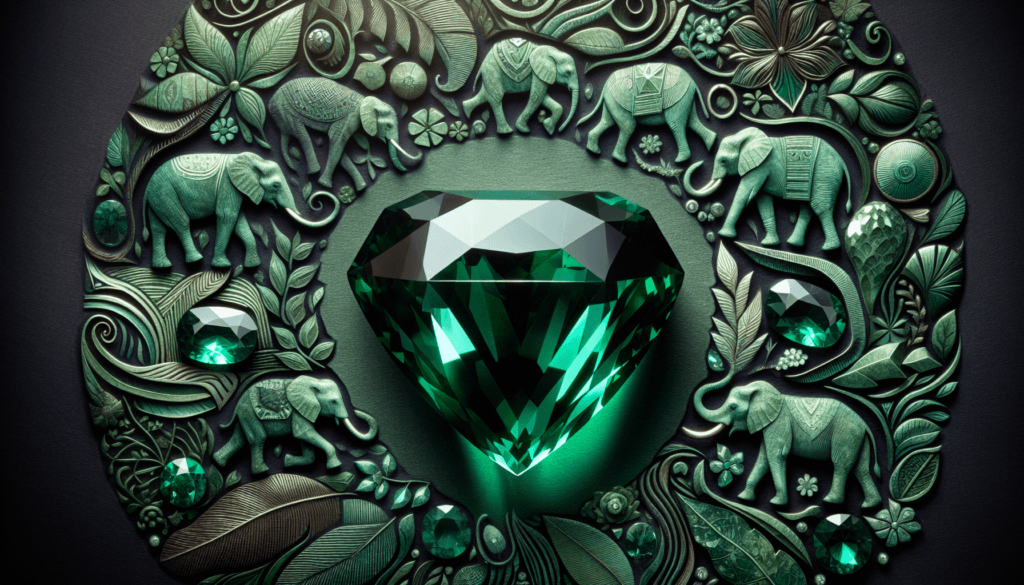Have you ever wondered how a gemstone can make a difference in wildlife conservation? The “Emeralds for Elephants” auction might just hold the answer to that intriguing question. Picture this: a glittering collection of exquisite, elephant-themed jewelry that not only captures the splendor of emeralds but also supports the cause of elephant conservation. An auction held at the majestic Taj Mahal Palace in Mumbai brought together luxury, craftsmanship, and philanthropy in one stellar event. Let’s unfold the success story of this remarkable auction and its broader implications for both the gemstone industry and wildlife conservation.
The Genesis of “Emeralds for Elephants”
A peculiar name, isn’t it? The “Emeralds for Elephants” initiative marries two worlds that might seem worlds apart: the sparkling realm of luxury gemstones and the earthy, raw reality of wildlife conservation. The goal? To raise awareness and funds for the preservation of elephants facing threats from poaching and habitat loss.
A Gemfields Initiative
Gemfields, a leading supplier of responsibly sourced colored gemstones, spearheaded this initiative. Known for its commitment to ethical mining practices, Gemfields envisioned “Emeralds for Elephants” as a beautiful fusion of art and activism. By using their spectacular Zambian emeralds, they crafted a line of jewelry as breathtaking as it is meaningful.
The Role of Jewelry Designers
To make this vision a reality, Gemfields collaborated with eminent jewelry designers who had the task of creating pieces that would embody both luxury and the gentle giants of the wild. Each designer brought their unique flair and artistic insight, resulting in a collection that not only radiated beauty but also told a story of guardianship over our planet’s magnificent creatures.
The Auction Event
Now, imagine that high-ceilinged ballroom at the Taj Mahal Palace, glittering not just with the stunning jewelry on display but with the palpable sense of purpose filling the room.
Setting the Scene
The venue itself was no ordinary choice. The Taj Mahal Palace in Mumbai, with its rich tapestry of history and hospitality, played host to an evening that blended elegance with earnestness. Elite circles, including jewelry aficionados, conservationists, and philanthropists, gathered here, not only to bid on fine jewelry but to contribute to a larger narrative of conservation.
A Charitable Affair
The auction wasn’t merely about the transactions of luxury items but about the transformational impact these purchases could enable. With proceeds going towards organizations dedicated to elephant conservation, each bid symbolized a commitment to sustainability and wildlife protection. This charity-oriented approach underscored the thought that luxury need not exist in isolation from responsibility.

The Success Metrics
In assessing the success of the “Emeralds for Elephants” auction, multiple layers come to light.
Financial Triumph
On purely monetary terms, the auction was a resounding success, raising substantial funds earmarked for conservation projects. This financial success serves as a testament to the power of meaningful intersections—where the allure of high-end jewelry meets the critical needs of ecological preservation.
| Auction Outcome | Impact |
|---|---|
| Funds Raised | Significant financial contributions for conservation efforts |
| Pieces Sold | All pieces auctioned off successfully |
| Participating Designers | Expanded public recognition for their role in conservation |
Raising Awareness
Beyond financial gains, the auction successfully captured public interest, shining a spotlight on the critical issue of elephant conservation. This awareness-raising aspect extended the auction’s influence, prompting conversations around ethical consumption and the role of industries in promoting wildlife preservation.
Corporate Responsibility and Ethical Consumption
In today’s world, conscious consumerism stands out. There’s a growing expectation for corporations to imbue their business practices with a sense of responsibility, particularly towards environmental concerns.
Gemfields’ Commitment
Gemfields, already noted for its ethical business model, further cemented its reputation through this auction. By aligning their brand with a cause, they showed how luxury goods could responsibly pair with conservation principles. Their approach emphasized transparency in their operations, from ethical mining to the sustainable creation and marketing of their products.
Consumer Influence
For consumers, especially those with purchasing power in luxury markets, the auction offered a path to impact. It reinforced the notion that buyers could wield their influence by choosing companies and products that prioritize ethical and sustainable practices, thus, contributing to the larger conservation narrative.

The Broader Impact on Wildlife Conservation
Beyond the immediate success of the auction, let’s ponder the more enduring influences on wildlife conservation.
Funding Conservation Efforts
The funds raised fuel ongoing efforts to curb poaching, secure habitats, and promote the coexistence of humans and elephants. By channeling resources to organizations on the frontline, such initiatives empower conservation projects to adopt more holistic, long-term strategies.
Elevating Global Conservation Discourse
Events like the “Emeralds for Elephants” auction provoke vital discussions on a global stage. By linking high-end markets with conservation, they implode traditional boundaries, bringing new participants into the conversation and amplifying the reach of conservation messages.
Future Prospects for Similar Initiatives
Given the success of the “Emeralds for Elephants” auction, what lies ahead for similar endeavors?
Replicating the Model
The successful fusion of luxury and conservation suggests a replicable model. Industries that deal in opulence have both the responsibility and the potential to drive positive change. Emulating the “Emeralds for Elephants” model could inspire other sectors to forge partnerships that create tangible environmental impacts.
Encouraging Cross-Industry Collaborations
This event paves the way for more cross-industry partnerships, where corporations join forces with non-profits, leveraging each other’s strengths to address critical ecological issues. Such collaborations extend the influence of both sectors, enhancing their capacity to effect meaningful change.
Challenges and Opportunities
Of course, such initiatives are not without challenges. Ensuring transparency, maintaining ethical standards, and avoiding mere tokenism require vigilance and commitment. However, the opportunities—raising awareness, influencing consumer behavior, and contributing to tangible conservation outcomes—are immensely rewarding.
Conclusion
The “Emeralds for Elephants” auction did more than just showcase exquisite jewelry; it spotlighted the potent interplay between luxury and responsibility. By successfully marrying these two realms, it crafted not just pieces of jewelry but pieces of a better future.
This auction stands as a beacon for what can be achieved when industries leverage their resources and influence for the greater good. It reminds us that with a touch of creativity, a dash of collaboration, and a hefty dose of dedication, we can turn the sparkle of emeralds into hope and healing for elephants. As you consider your next luxury purchase, remember the impact your choice can have. Let it be more than an investment in beauty—let it be a beacon of positive change.
